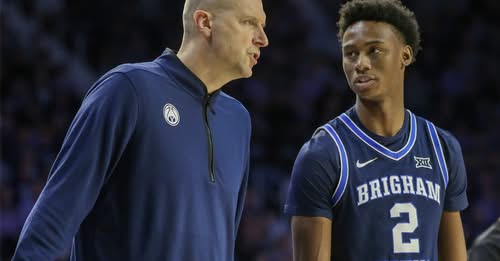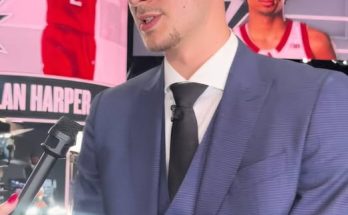Mark Pope’s tenure as head coach at BYU has been marked by an evolution of talent, and one of the most exciting facets of his coaching career has been his ability to cultivate growth among his players, especially during their second year. The transition from a freshman to a sophomore season can be challenging for many athletes, but under Pope’s guidance, several players have demonstrated significant improvement, making their second-year jumps a defining aspect of the program’s success.
When Pope arrived at BYU in 2019, he inherited a team with a mix of veteran leadership and promising underclassmen. The development of those underclassmen, especially those making their way into their second year, has become a hallmark of his coaching. Pope has been known to give players the tools to succeed, both on and off the court, fostering an environment where improvement is not just encouraged but expected.
For some players, the second-year leap under Pope has been a natural progression of skills, while for others, it’s been a transformation driven by hard work, experience, and enhanced confidence. Pope has a keen eye for recognizing the potential in his players and helping them refine their abilities, and that’s been evident in the performances of several key second-year players.
One of the standout examples of this growth is Alex Barcello, who took a significant leap in his second year under Pope. After transferring from Arizona, Barcello had a solid freshman season, but his sophomore year saw a complete transformation. His scoring, playmaking, and leadership on the floor became central to BYU’s success. Barcello emerged as one of the premier guards in the West Coast Conference, and his improvement wasn’t just about statistical growth, but also about his leadership role, guiding the team through tough matchups and helping to elevate the play of his teammates. Under Pope, Barcello learned to embrace the role of a floor general, making better decisions with the ball and showcasing a knack for clutch performances. His second-year jump was not only a testament to his skills but also a reflection of Pope’s ability to unlock potential in players.
Another player who made a significant leap in his second year was Caleb Lohner. Lohner’s freshman season showed flashes of potential, but his sophomore year was when he truly began to break out. Under Pope’s system, Lohner developed into one of the most versatile players on the team, able to impact the game in a variety of ways. Whether it was his rebounding, defense, or scoring, Lohner became a more complete player in his second year, and his confidence on the floor skyrocketed. Pope has a knack for bringing out the best in his players, and Lohner’s development into a more aggressive and well-rounded player was a prime example of Pope’s influence.
In addition to Barcello and Lohner, other players have seen notable improvements during their second season under Pope. For instance, Connor Harding, who was known for his defensive abilities, showed increased offensive production during his sophomore year. Harding’s development as a reliable shooter and a more consistent offensive threat gave BYU additional scoring options, which was crucial for a team that needed more depth.
Similarly, Richard Harward, a big man who transferred to BYU before his sophomore season, experienced substantial growth under Pope. Harward’s conditioning and understanding of the team’s offensive and defensive schemes improved dramatically, which allowed him to become a more effective presence in the post. His second-year jump was one of the key factors in the team’s ability to compete at a high level in the conference, particularly in the absence of more established big men.
The consistent theme in these second-year jumps is Pope’s emphasis on development, both from a physical and mental standpoint. He’s not only focused on refining players’ technical skills but also helping them mature as individuals and athletes. His leadership style fosters an atmosphere where players feel supported and challenged, which leads to growth both on and off the court.
Pope’s ability to help players improve during their second year has had a significant impact on the overall trajectory of BYU’s basketball program. The program has become known for its player development, particularly in the case of young athletes who may not have received the same amount of attention or coaching at their previous programs or in their first year. Pope’s system encourages players to reach their full potential, and those who make the most of their second-year jumps often find themselves playing prominent roles on a team that is poised for success.
This emphasis on player development has also contributed to BYU’s success in the West Coast Conference and their ability to compete on the national stage. The team’s growth, thanks to the improvement of its key players, has translated into higher-quality basketball and more consistent performances throughout the season. Pope’s focus on developing players for the long term, rather than just for a single season, ensures that the team remains competitive year after year.
In many ways, Mark Pope’s coaching philosophy revolves around the idea that a player’s second year is when they should truly begin to flourish. Under his tutelage, athletes don’t just survive their sophomore seasons—they thrive. Pope’s approach helps players refine their skills, become more confident in their abilities, and find their roles within the team. This has resulted in a program that not only competes at a high level but also develops talent that is capable of sustaining that level for years to come.
As BYU continues to grow under Mark Pope, it will be interesting to see which new players take the leap in their second year. The success of previous second-year players serves as a reminder of what’s possible when athletes have the right coaching and the right system in place. Pope’s ability to cultivate that growth is a big reason why BYU basketball remains on the rise, with players consistently showing marked improvements year after year.



